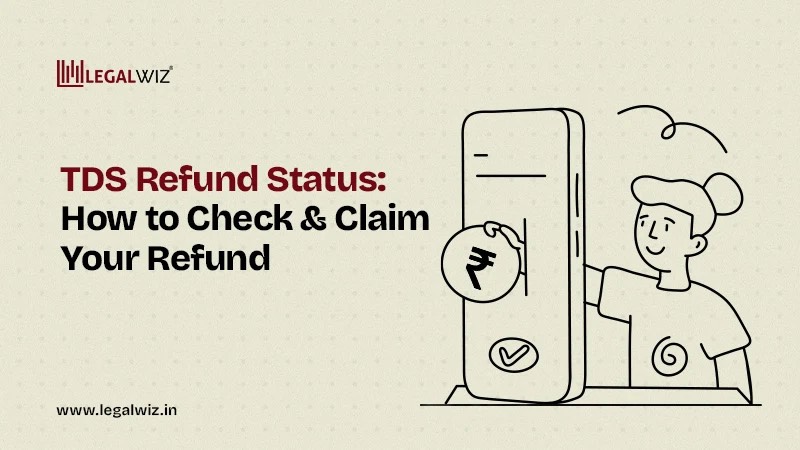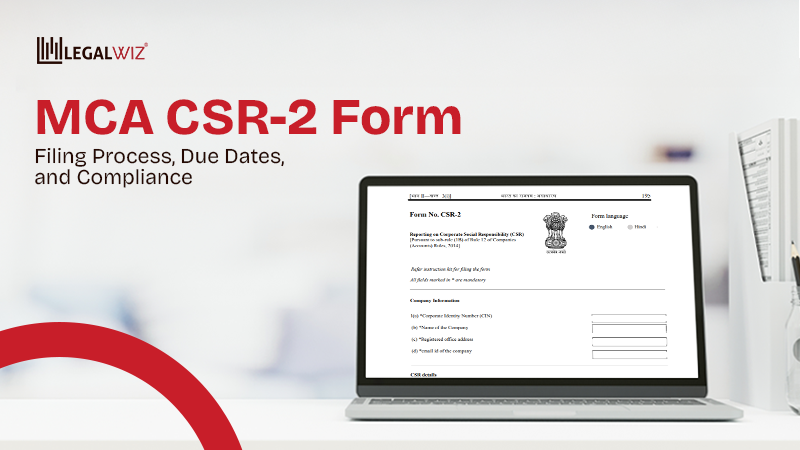TDS Refund Status: How to Check & Claim Your Refund
Every year, countless taxpayers unknowingly give the Income Tax Department a free ride with their money, thanks to extra TDS deductions, advance tax miscalculations, or tiny filing errors. But here’s the twist: this money doesn’t vanish into thin air. It simply sits there, earning zero interest for you, patiently waiting to be claimed.
And here’s where most people go wrong, filing the ITR and calling it a day. But here’s the plot twist: that’s just the starting line. If you’re not keeping tabs on your TDS refund status, you might be left in the dark—whether it’s cruising along nicely, stuck in a mismatch mess, or (gulp!) accidentally chilling in someone else’s account.
Want your hard-earned money back minus the mystery and the wait? We’ve got you. Check out this step-by-step guide to claiming your TDS refund.
Monitoring your refund isn’t just about curiosity—it’s about:
- Recovering what’s yours, faster
- Catching errors before they snowball into months of waiting
- Earning interest on delayed refunds
- Enjoying peace of mind after the tax-season madness
In short, checking your TDS refund status is like keeping an eye on your own vault—because no one else will.
What is TDS & Why Refunds Happen?
TDS, aka Tax Deducted at Source—is the government’s way of saying, “We’ll take our cut now, thank you very much.” Whether it’s your employer, your bank, or anyone else sending money your way, they deduct tax right at the payment source. Filing your TDS online isn’t just good manners, it helps you dodge penalties and claim those sweet, sweet refunds.
But here’s the twist: sometimes, more tax gets snatched than you actually owe. Why? A few usual suspects:
- Higher-than-necessary TDS on salary, interest, or professional payments
- Multiple employers or income sources
- Incorrect calculation or application of exemptions and deductions
When this happens, the extra tax you’ve paid doesn’t just disappear; you are entitled to get it back. Enter: the TDS refund process, your financial boomerang.
By filing your Income Tax Return (ITR) and checking your TDS refund status, you can claim any extra tax that was (politely or not) over-collected. Bonus? If there’s a delay, the tax department might even throw in some interest as a peace offering.
TDS Refund Process – Step-by-Step Guide
Claiming your TDS refund isn’t rocket science, but let’s be honest—it’s not a stroll in the park with a latte and no worries either. You need to get the details right to make sure your money boomerangs back to your bank account where it belongs.
So buckle up, here’s your no-nonsense, mildly caffeinated roadmap to a successful refund:
Step 1: Filing an Accurate ITR
The journey starts here. Your Income Tax Return (ITR) is your official request to the tax department saying, “Hey, that extra tax? I’ll take it back now, thanks.”
- Your PAN and personal details match official records
- All sources of income (salary, bank interest, freelancing, etc.) are declared
- TDS entries align with Form 26AS and AIS
- Bank account details (for refund credit) are correct and pre-validated
Step 2: Matching TDS Details with Form 26AS/AIS
Form 26AS and AIS are your tax report cards, listing all income and TDS tied to your PAN. Before hitting “Submit” on your ITR, match them with your salary slips and interest certificates. Mismatches = refund delays. Don’t let your money play hide and seek!
Step 3: Verification & Processing by the Income Tax Department
Once you file your ITR, the IT Department verifies your return. This includes:
- Checking the accuracy of income, deductions, and TDS credits.
- Confirming bank account details.
- Resolving any mismatch issues or notices, if applicable.
During this stage, your refund amount is calculated and approved for transfer.
Step 4: Timeline from Filing to Refund Credit
Tax refunds can feel like a bit of a lottery, how fast you get paid depends on how well you play the game.
- E-file + e-verify? You’re in the fast lane: 20–45 days.
- Paper file or manual verification? Buckle up—2–3 months (or more).
The silver lining? Refunds land straight in your bank account. And if they’re fashionably late, the taxman might just toss in some interest as a thank-you for your patience.
| Before diving into the refund process, make sure your paperwork squad is ready to roll—nothing slows things down like missing documents. For the full checklist, check out this guide on documents required to file TDS online and get everything sorted from the get-go. |
Pro Tip: Keep your ITR acknowledgment number handy; it’s your tracking ID for the refund status and any communications from the IT Department.
How to Check Your TDS Refund Status?
Checking your TDS refund status is easier than hunting for lost socks, but it still needs a little guidance. You can track your refund online using the Income Tax e-filing portal or the NSDL (now Protean) TDS portal. Here’s how:
Option 1: Income Tax e-Filing Portal
- Log in to https://www.incometax.gov.in using your PAN and password.
- Navigate to “My Account” → “Refund/Demand Status.”
- Enter the Assessment Year and click “Submit.”
- You’ll see your refund status, whether it’s Processed, Pending, or Credited.
Option 2: NSDL (Protean) TDS Portal
- Go to the Protean TDS portal, which manages TDS information.
- Click on “View TDS Refund Status.”
- Enter your PAN, Assessment Year, and Captcha.
- Click “Submit” to check the status.
Quick Summary in Simple Steps
- Log in to the portal (Income Tax e-filing or NSDL/Protean).
- Select Assessment Year.
- Enter required details (PAN, captcha, etc.).
- View the current status of your refund.
Pro Tip: Keep your ITR acknowledgment number with you; it helps in faster resolution if there’s any delay or mismatch.
How Can I Get TDS Refund Faster?
Tired of playing the waiting game for your TDS refund? It doesn’t have to be that way. A few smart moves can fast-track the process and keep delays at bay. Here’s how to stay ahead of the curve:
1. File Your ITR Early
The sooner you file your Income Tax Return (ITR), the faster your refund gets moving. Waiting until the last minute? That just puts your refund in the slow lane, stuck in the backlog traffic.
2. Ensure Accuracy in PAN, Bank, and Income Details
Even a tiny typo in your PAN, bank account number, or IFSC can stall your refund or get it rejected. Make sure:
- Your PAN and name match exactly with Form 26AS/AIS.
- Your bank account is active and linked to your PAN.
- Income and TDS details line up with your salary slips and statements.
3. Verify TDS Entries Before Filing
Match those TDS deductions in Form 26AS with your salary slips and interest certificates. Mismatches are like spoilers—nobody wants them and they just delay the fun (aka your refund).
4. Opt for E-Filing & E-Verification
Skip the paper chase! Filing and verifying online is like hopping on a bullet train versus a rickshaw. Zoom zoom, refund begins ASAP.
5. Respond Promptly to Notices
If they send you a notice, reply faster than you ghost your group chats. Delays here = refund in slow-mo.
Pro Tip: Link Aadhaar with your PAN and bank account to cut through red tape like a hot knife through butter.
Follow these, and watch your refund slide into your bank account smoother than your favorite playlist.
Common Reasons for Delay or Rejection
Even after filing your ITR perfectly, sometimes your TDS refund can hit a roadblock. Knowing the common culprits helps you avoid unnecessary headaches. Here’s what usually slows things down or leads to rejection:
1. Mismatch in TDS Data
The Income Tax Department cross-checks the TDS details in your ITR against Form 26AS / AIS. Any mismatch, like a missing TDS entry, wrong amount, or incorrect PAN, can trigger delays or notices.
2. Unverified Returns
Filing your ITR is only half the job. If your return isn’t verified electronically (e-verified) or via physical submission, the refund process doesn’t begin. Many taxpayers miss this step, causing unnecessary hold-ups.
3. Incorrect Bank Details or IFSC Code
Even one wrong digit in your bank account or IFSC can send your refund on a detour. Always ensure your account is active, correctly linked to PAN, and error-free.
4. Pending Compliance Notices
If the IT Department sends you a notice, whether for a mismatch, clarification, or extra info, your refund’s basically stuck in traffic until you reply quickly and clearly.
Quick Tip: Keep an eye on your refund status and IT portal notifications like it’s your favorite show. Spotting issues early can save you weeks (or even months!) of waiting.
Found errors? Fix them fast! Delays here mean delays in your refund party. For the full scoop on correction types and how to fix them, check out this handy guide on types of corrections in TDS returns.
Fun Twist: What Are the Types of Audit & Why They Matter for TDS?
You might think audits are just for big businesses or complicated accounts, but they actually tie in with your TDS refund, too! Even small errors uncovered in audits can delay refunds or trigger notices.
Types of Audits That Affect TDS:
- Tax Audit
Conducted under Section 44AB of the Income Tax Act, tax audits ensure that your books of accounts are accurate and compliant with tax laws. If discrepancies in TDS or income reporting are found, refunds can be delayed until rectification.
- Internal Audit
Done internally by businesses to catch errors early, internal audits often spot TDS mismatches or incorrect entries before filing the ITR. This proactive step helps prevent refund delays.
- Statutory & Other Audits
Other audits (like GST audit or company statutory audit) may indirectly affect your TDS refund if income, deductions, or TDS entries are under scrutiny.
Why It Matters for You:
Even if you’re a salaried individual, minor errors, like mismatched TDS credits or missed deductions, can trigger IT notices or slow down refund processing. Keeping accurate records and double-checking your TDS entries makes the process smoother.
Think of audits as the tax watchdogs; a little oversight now saves you from chasing refunds later!
Final Thoughts – “Check, Claim & Chill!”
Your TDS refund isn’t just some random number buried in a statement—it’s your money. You already paid it through salary deductions, bank interest, or other payments. Ignoring it? That’s like leaving cash on the table and hoping it strolls back to you. Spoiler: it won’t.
To make sure every hard-earned rupee finds its way back to you, here’s your quick cheat sheet:
- Check Your Refund Status Regularly – Don’t hit cruise control and hope for the best. Track your refund to catch mismatches, errors, or any processing hiccups before they become a headache.
- Claim Accurately – Filing your ITR isn’t the place for guesswork. Double-check your PAN, bank account, and income details, accuracy here means fewer delays and more money, faster.
- Resolve Issues Promptly – Got a notice? Don’t ignore it. Respond ASAP to avoid refund limbo or outright rejection. Silence = delay.
By following these steps, you don’t just speed things up—you dodge stress, penalties, and missed interest.
Our experts at LegalWiz.in take the pain out of paperwork. From verifying your TDS entries to filing your ITR right, it’s like having a personal tax sidekick who knows all the shortcuts.
Remember: Your refund isn’t a bonus, it’s your right. Check it. Claim it. Then kick back, relax, and enjoy the sweet satisfaction of getting your money back where it belongs.
Frequently Asked Questions
How can I check my TDS refund status?
Easy peasy! Just log in to the Income Tax e-filing portal or the NSDL (now Protean) TDS portal, punch in your PAN and assessment year, and boom—you’ll see if your refund is Pending, Processed, or Credited. Like checking your pizza delivery status… but with more paperwork.
How long does it take to get my TDS refund?
Filed and e-verified online? You could see that sweet refund in 20–45 days. Filed on paper or hit a snag? You’re in for a wait—2 to 3 months or more. Speed depends on how neat your tax game is.
Can I claim a TDS refund from earlier years?
You bet—but there’s a ticking clock! You’ve got up to 2 years from the end of the relevant assessment year to file a belated or revised ITR. Wait too long, and your refund stays on permanent vacation.
What if my refund is delayed?
Good news: the tax department pays you interest if they take too long. Bad news: it’s still annoying. Check your status regularly, fix errors fast, and save yourself from the refund waiting game blues.
Can an audit mess with my refund?
Oh, for sure! Tax or internal audits can sniff out mismatches or slip-ups that throw a wrench in your refund—or worse, land you a love letter (aka a notice) from the IT department. So stay sharp, keep your paperwork tidy, and don’t let audits crash your refund party!

Sapna Mane
Sapna Mane is a skilled content writer at LegalWiz.in with years of cross-industry experience and a flair for turning legal, tax, and compliance chaos into clear, scroll-stopping content. She makes sense of India’s ever-changing rules—so you don’t have to Google everything twice.







